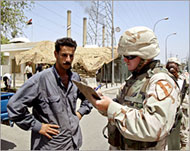Fear and mistrust deepen in Iraq
Since the US announced on 4 April its intention to arrest the Shia leader Muqtada al-Sadr, occupation forces have been engaged in a series of deadly clashes with militiamen loyal to him.

Fighting in and around Najaf has been particularly fierce and US special forces soldiers have been kept busy by the Mahdi Army amid several failed attempts to arrive at a peace deal.
On a recent day, a cloud of dust billowed from the approach road to the occupation base in Najaf. As an American sentry shouted instructions to open the gate, another US soldier hurriedly pulled back a barbed-wire barricade.
Two 4x4s roared through the entrance of the base.
The windows of the vehicles were blacked out, and portraits of Shia figures including al-Sadr – images that are quite popular with Iraqi Shias – were affixed to the rear doors.
Baseball caps
As the vehicles passed through the gate, a staff sergeant radioed ahead to the headquarters to inform them that “Captain Barnes and his special forces team have just re-entered the compound”.
The special forces’ clumsy attempts to camouflage themselves – such as decorating four-wheel vehicles with Islamic religious portraits – have predictably drawn criticism from their regular army counterparts.
One soldier at the Najaf gate suggested that “their ruse might be more effective if the special forces teams weren’t still wearing baseball caps and sunglasses. That is not exactly the standard garb for deeply religious Shias”.
 |
|
The 4×4 vehicles preferred by US |
Additionally, US special forces and many private security contractors have purchased older-model 4x4s from Iraqi taxi drivers.
Although painted in the standard orange and white pattern of the local taxis, the modified 4x4s are still easily spotted by the resistance fighters.
“All they have to do is look for the special GPS [global positioning system] and communication antennas to pick out the Americans,” said Anmar al-Saadi, a former soldier in Saddam’s Presidential Guard.
“The Baghdad airport highway is littered with the remains of these disguised GMCs as proof that they are not fooling anyone but themselves.”
No chances
The uniformed occupation forces that perform the role of regular convoy escorts and patrols, however, have long since adopted a “fire first” policy for self-protection.
For their part, Iraqi civilian drivers have learned to remain well behind American vehicles. They no longer risk trying to accelerate past a convoy along a highway’s paved shoulder.
“Things have changed in the past few months, and the Americans have become far more ruthless in their behaviour,” said Yashar, a community leader in Talaffar, a predominantly ethnic Turkmen city.
“We have had 13 civilians killed accidentally by American vehicles or bullets, and now our drivers take no chances.”
 |
|
Associating with the occupation |
US troops are also taking no chances when it comes to trusting the loyalty of the newly formed Iraqi police and army units.
When the resistance’s escalation of attacks occurred in April, an estimated 40% of Iraqi security personnel simply went home and refused to fight while another 10% turned their guns on the US-led occupation.
“We watch the ICDC [Iraqi civil defence corps] very carefully now since our quick response team caught one of their detachments firing mortars at our air base,” said a Canadian maintenance contractor stationed in Mosul.
“They arrested the culprits, but ever since there has been some tension between the ICDC and US soldiers.”
With the Iraqi resistance targeting and capturing an increasing number of foreign nationals, local drivers and shopkeepers have become afraid to even be associated with international clients.
Active resistance
During my previous visits to Iraq this was not an issue, but on this trip my driver frequently requested that I pretend to be asleep in the back seat so as not to attract attention.
Despite our precautions, on 6 June, as we drove along the Najaf-Baghdad highway, we were followed closely for several kilometres by a grey minibus.
Although we managed to lose the vehicle in heavy traffic and subsequently dismissed our fears as groundless, we later learned that a film crew from Aljazeera was ambushed on that same stretch of highway just 20 minutes after our passage.
The attack was reported in the news as a drive-by shooting from a grey minivan.
The resistance has also stepped up reprisal attacks against Iraqis they regard as collaborating with occupation forces or providing them with intelligence.
 |
|
On highways Iraqi drivers avoid |
“When the US troops first came to Talaffar, the Turkmen citizens were very happy to see them because it meant that the terror of Saddam had ended,” explained Yashar.
“However, things have steadily worsened and the resistance is now very active in Talaffar.”
As a result of the escalating attacks against their personnel and facilities, in mid-May the occupation consolidated its position by withdrawing all US troops to the air base located some five kilometres outside this northwestern Iraqi city.
“No local driver will take you to the American camp,” said Yashar. “First because they fear being shot by US troops as they approach the gate. But more than that, they know the resistance is constantly observing the Americans.
“To meet them means that the resistance will kill the driver upon his return home,” he said.